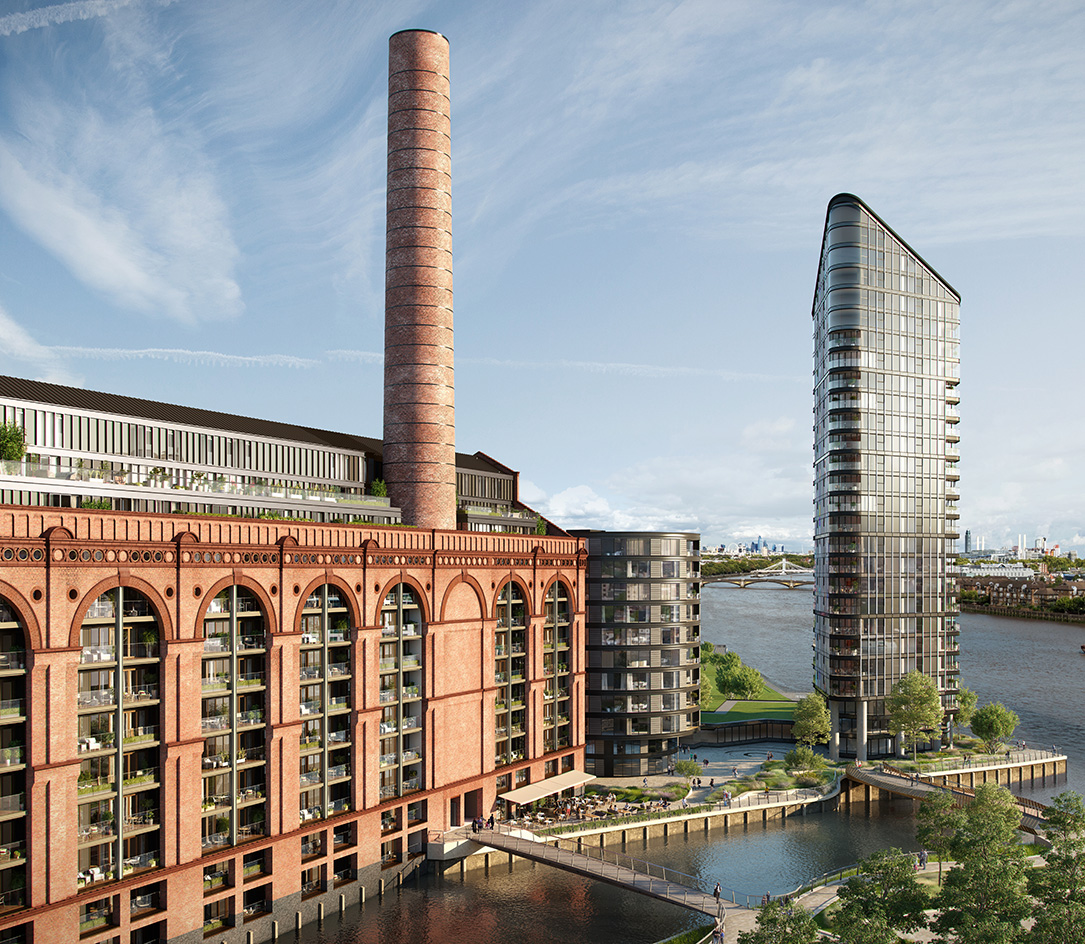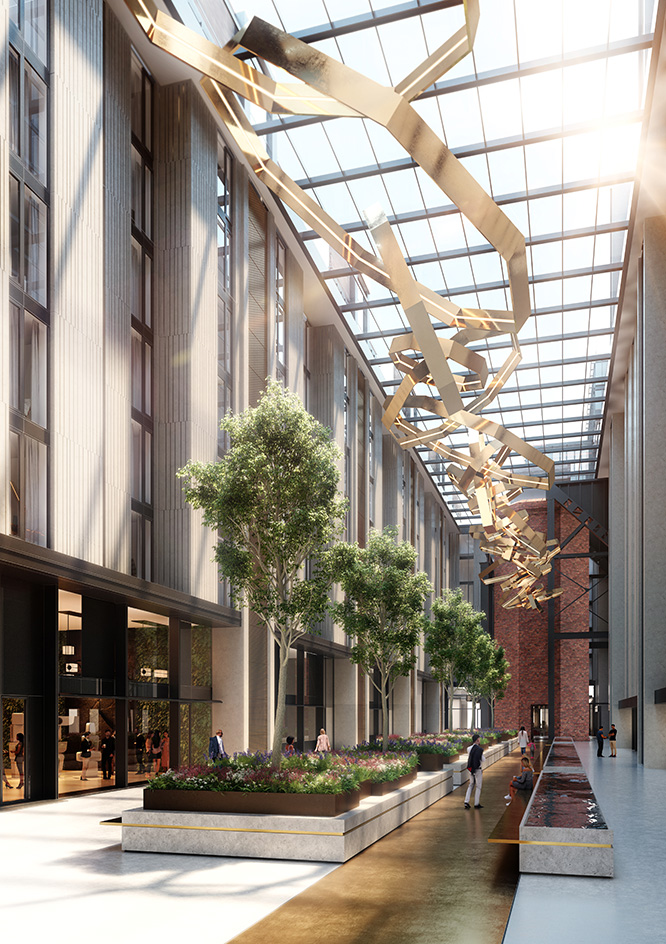Powerhouse at Chelsea Waterfront transforms Lots Road Power Station

The last of London's three main power stations, Lots Road Power Station, has launched its redesign. Welcome to Powerhouse at Chelsea Waterfront, which, together with the Tate Modern and Battersea Power Station, completes the trio of important pieces of London energy infrastructure and industrial architecture that have now entered a new phase in their life.
Nestled by the water just off the River Thames, this historical coal and later oil-fired and gas-fired power station was originally built in 1905, but has remained disused for decades. Developer CK Asset Holdings Limited took on the site to transform it into a mixed-use scheme, which offers from private to affordable housing, commercial and retail units, and public space, while honouring the structure's industrial heritage. The sales launch of Powerhouse at Chelsea Waterfront was recently announced, bringing some 200 new homes onto the market.

Archive photograph of Lots Road Power Station in operation in London
A team of architects led by Sir Terry Farrell has been working to restore the original building's historic red brick walls (it was hailed as the first steel-framed building in the British Isles). Construction is well underway, with Fiona Barratt Interiors working with the architects on the spaces inside – these include luxurious residential areas but also dramatic publically accessible atria in the old turbine hall. Old meets new everywhere in this project, and while the building's appearance and main bones were maintained, inside much is contemporary, ensuring the building can offer the best for its new, domestic function. A distinctive element that makes this power station stand out among its peers is its huge, elegant arched windows – which also mean it is particularly well suited to a residential conversion.
Powerhouse will be serviced by amenities that form part of the Chelsea Waterfront wider scheme – including around-the-clock house management, a health and fitness centre, a spa, a fully equipped gym, a 20m swimming pool, and a club lounge for residents.

‘Powerhouse is an iconic London landmark and a cathedral of the industrial age that has been rejuvenated by a world-class team of architects and designers. Taking on a revolutionary new form, Powerhouse will offer a 21st-century living experience like no other in one of London’s most coveted boroughs,' said Hutchison Property Group's Dr Edmond Ho.





Receive our daily digest of inspiration, escapism and design stories from around the world direct to your inbox.
Ellie Stathaki is the Architecture & Environment Director at Wallpaper*. She trained as an architect at the Aristotle University of Thessaloniki in Greece and studied architectural history at the Bartlett in London. Now an established journalist, she has been a member of the Wallpaper* team since 2006, visiting buildings across the globe and interviewing leading architects such as Tadao Ando and Rem Koolhaas. Ellie has also taken part in judging panels, moderated events, curated shows and contributed in books, such as The Contemporary House (Thames & Hudson, 2018), Glenn Sestig Architecture Diary (2020) and House London (2022).
-
 We gaze into our crystal ball to predict the tech hits (and misses) of 2026
We gaze into our crystal ball to predict the tech hits (and misses) of 2026The shape of things to come: seven technologies that will define the year ahead, from robotics, AI, aviation and more
-
 This documentary tells the story behind Louis Vuitton’s monumental Snakes and Ladders runway set
This documentary tells the story behind Louis Vuitton’s monumental Snakes and Ladders runway setThe new film offers a rare behind-the-scenes glimpse at how Pharrell Williams and Studio Mumbai conceived the 2,700 sq ft Snakes and Ladders board, which backdropped the house’s S/S 2026 menswear collection last June
-
 This remarkable retreat at the foot of the Catskill Mountains was inspired by the silhouettes of oak leaves
This remarkable retreat at the foot of the Catskill Mountains was inspired by the silhouettes of oak leavesA New York City couple turned to Desai Chia Architecture to design them a thoughtful weekend home. What they didn't know is that they'd be starting a farm, too
-
 You can soon step inside David Bowie’s childhood home
You can soon step inside David Bowie’s childhood homeWith a set completion date by 2027, the musician's childhood home in Bromley will be restored to its original 1960s appearance, including Bowie’s bedroom, the launchpad for his long career
-
 Welcome to The Float House, proof that life on London’s canals can be warm and elegant
Welcome to The Float House, proof that life on London’s canals can be warm and elegantMoored on London’s Grand Union Canal, The Float House, designed by TiggColl Architects, reimagines what a houseboat can be
-
 Fulham FC’s new Riverside Stand by Populous reshapes the match-day experience and beyond
Fulham FC’s new Riverside Stand by Populous reshapes the match-day experience and beyondPopulous has transformed Fulham FC’s image with a glamorous new stand, part of its mission to create the next generation of entertainment architecture, from London to Rome and Riyadh
-
 This modern Clapham house is nestled indulgently in its garden
This modern Clapham house is nestled indulgently in its gardenA Clapham house keeps a low profile in south London, at once merging with its environment and making a bold, modern statement; we revisit a story from the Wallpaper* archives
-
 This curved brick home by Flawk blends quiet sophistication and playful details
This curved brick home by Flawk blends quiet sophistication and playful detailsDistilling developer Flawk’s belief that architecture can be joyful, precise and human, Runda brings a curving, sculptural form to a quiet corner of north London
-
 Arbour House is a north London home that lies low but punches high
Arbour House is a north London home that lies low but punches highArbour House by Andrei Saltykov is a low-lying Crouch End home with a striking roof structure that sets it apart
-
 In addition to brutalist buildings, Alison Smithson designed some of the most creative Christmas cards we've seen
In addition to brutalist buildings, Alison Smithson designed some of the most creative Christmas cards we've seenThe architect’s collection of season’s greetings is on show at the Roca London Gallery, just in time for the holidays
-
 The Architecture Edit: Wallpaper’s houses of the month
The Architecture Edit: Wallpaper’s houses of the monthFrom wineries-turned-music studios to fire-resistant holiday homes, these are the properties that have most impressed the Wallpaper* editors this month